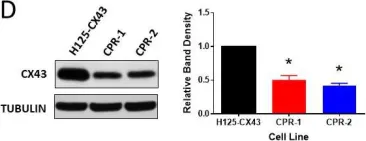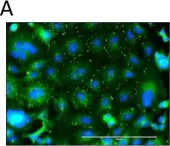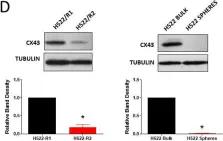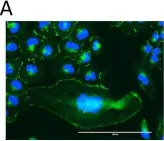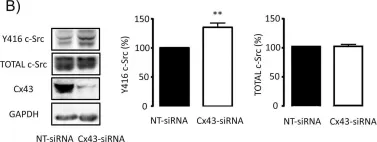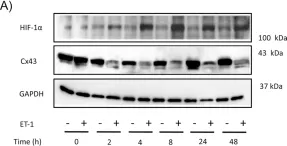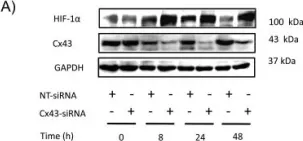Dissociated glial and neuronal precursors from the spinal cord or cerebral cortex of late rat embryos are cultured on top of glass coverslips to ascertain the in vitro effects of high glucocorticoid levels on the process of myelination and on astrocyte markers during postnatal development and determine the dependence of those effects on glucocorticoid receptor activation. The study includes the immunohistochemical processing of culture-carrying coverslips with antibodies to astrocytic, neuronal, oligodendroglial, and myelin proteins to determine changes in those markers after glucocorticoid treatment. In addition, we describe oligodendrocyte-astrocyte cultures from neonatal embryos to determine the effects of high glucocorticoids on the morphology of oligodendrocytes in the absence of developing neurons.
© 2025. The Author(s), under exclusive license to Springer Science+Business Media, LLC, part of Springer Nature.
Product Citations: 50
In Methods in Molecular Biology (Clifton, N.J.) on 20 March 2025 by Miguel-Hidalgo, J. J. & Pang, Y.
-
Biochemistry and Molecular biology
-
Neuroscience
In Journal of Translational Medicine on 14 August 2024 by Wong, C. E., Liu, W., et al.
Satellite glial cells (SGCs) in the dorsal root ganglia (DRG) play a pivotal role in the formation of neuropathic pain (NP). Sciatic nerve stimulation (SNS) neuromodulation was reported to alleviate NP and reduce neuroinflammation. However, the mechanisms underlying SNS in the DRG remain unclear. This study aimed to elucidate the mechanism of electric stimulation in reducing NP, focusing on the DRG.
L5 nerve root ligation (NRL) NP rat model was studied. Ipsilateral SNS performed 1 day after NRL. Behavioral tests were performed to assess pain phenotypes. NanoString Ncounter technology was used to explore the differentially expressed genes and cellular pathways. Activated SGCs were characterized in vivo and in vitro. The histochemical alterations of SGCs, macrophages, and neurons in DRG were examined in vivo on post-injury day 8.
NRL induced NP behaviors including decreased pain threshold and latency on von Frey and Hargreaves tests. We found that following nerve injury, SGCs were hyperactivated, neurotoxic and had increased expression of NP-related ion channels including TRPA1, Cx43, and SGC-neuron gap junctions. Mechanistically, nerve injury induced reciprocal activation of SGCs and M1 macrophages via cytokines including IL-6, CCL3, and TNF-α mediated by the HIF-1α-NF-κB pathways. SNS suppressed SGC hyperactivation, reduced the expression of NP-related ion channels, and induced M2 macrophage polarization, thereby alleviating NP and associated neuroinflammation in the DRG.
NRL induced hyperactivation of SGCs, which had increased expression of NP-related ion channels. Reciprocal activation of SGCs and M1 macrophages surrounding the primary sensory neurons was mediated by the HIF-1α and NF-κB pathways. SNS suppressed SGC hyperactivation and skewed M1 macrophage towards M2. Our findings establish SGC activation as a crucial pathomechanism in the gliopathic alterations in NP, which can be modulated by SNS neuromodulation.
© 2024. The Author(s).
-
IHC-IF
-
Neuroscience
-
Plant Science
In Cell Reports on 23 July 2024 by Visser, J., Milior, G., et al.
Astroglial networks closely interact with neuronal populations, but their functional contribution to neuronal representation of sensory information remains unexplored. The superior colliculus (SC) integrates multi-sensory information by generating distinct spatial patterns of neuronal functional responses to specific sensory stimulation. Here, we report that astrocytes from the mouse SC form extensive networks in the retinorecipient layer compared to visual cortex. This strong astroglial connectivity relies on high expression of gap-junction proteins. Genetic disruption of this connectivity functionally impairs SC retinotopic and orientation preference responses. These alterations are region specific, absent in primary visual cortex, and associated at the circuit level with a specific impairment of collicular neurons synaptic transmission. This has implications for SC-related visually induced innate behavior, as disrupting astroglial networks impairs light-evoked temporary arrest. Our results indicate that astroglial networks shape synaptic circuit activity underlying SC functional visual responses and play a crucial role in integrating visual cues to drive sensory-motor behavior.
Copyright © 2024 The Authors. Published by Elsevier Inc. All rights reserved.
-
Neuroscience
Expression and Function of Connexins in Extracellular Vesicles.
In Methods in Molecular Biology (Clifton, N.J.) on 5 April 2024 by Martins-Marques, T. & Girão, H.
Extracellular vesicles (EVs) are recognized as major vehicles for exchange of information across distant cells and tissues, which have been extensively explored for diagnosis and therapeutic purposes. The presence of multiple connexin (Cx) proteins has been described in EVs, where they might facilitate EV-cell communication. However, quantitative changes in Cx levels and functional assessment of Cx channels have only been established for Cx43. In present work, we provide a detailed description of the protocols we have optimized to assess the expression and permeability of Cx43 channels in EVs derived from cultured cells and human peripheral blood. Particularly, we include some modifications to improve quantitative analysis of EV-Cx43 by enzyme-linked immunosorbent assay (ELISA) and assessment of channel functionality by sucrose-density gradient ultracentrifugation, which can be easily adapted to other Cx family members, leveraging the development of diagnostic and therapeutic applications based on Cx-containing EVs.
© 2024. The Author(s), under exclusive license to Springer Science+Business Media, LLC, part of Springer Nature.
-
Biochemistry and Molecular biology
In GLIA on 1 January 2024 by Schumacher, S., Tahiri, H., et al.
Therapeutic brain irradiation with ionizing radiation exerts multiple side effects including barrier leakage that disturbs glial-neuronal functioning and may affect cognition. Astrocytes contribute to barrier leakage by endfeet release of various vasoactive substances acting on capillary endothelial cells forming the barrier. Here, we investigated X-ray effects on astrocytic vesicular transport in mice and determined whether interfering with astrocyte connexins affects radiation-induced barrier leakage. We found that astrocytic VEGF-A-loaded VAMP3 vesicles drastically reorganize starting from 6 h post-irradiation and move in a calcium- and Cx43-dependent manner towards endfeet where VEGF-A is released, provoking barrier leakage. Vesicular transport activation, VEGF-A release and leakage 24 h post-irradiation were all potently inhibited by astrocytic Cx43 KO, Cx43S255/262/279/282A (MK4) mutant mice and TATGap19 inhibition of Cx43 hemichannel opening. Astrocyte VEGF release is a major player in complications of brain irradiation, which can be mitigated by anti-VEGF treatments. Targeting Cx43 hemichannels allows to prevent astrocyte VEGF release at an early stage after brain irradiation.
© 2023 The Authors. GLIA published by Wiley Periodicals LLC.
-
WB
-
Cardiovascular biology
-
Neuroscience
In Cancers (Basel) on 2 February 2019 by Ruch, R. J.
Fig.1.A

-
WB
-
Homo sapiens (Human)
Collected and cropped from Cancers (Basel) by CiteAb, provided under a CC-BY license
Image 1 of 12
In Cancers (Basel) on 2 February 2019 by Ruch, R. J.
Fig.1.D

-
ICC-IF
-
Homo sapiens (Human)
Collected and cropped from Cancers (Basel) by CiteAb, provided under a CC-BY license
Image 1 of 12
In Cancers (Basel) on 2 February 2019 by Ruch, R. J.
Fig.5.D

-
WB
-
Homo sapiens (Human)
Collected and cropped from Cancers (Basel) by CiteAb, provided under a CC-BY license
Image 1 of 12
In Cancers (Basel) on 2 February 2019 by Ruch, R. J.
Fig.6.D

-
WB
-
Homo sapiens (Human)
Collected and cropped from Cancers (Basel) by CiteAb, provided under a CC-BY license
Image 1 of 12
In Cancers (Basel) on 2 February 2019 by Ruch, R. J.
Fig.7.B

-
WB
-
Homo sapiens (Human)
Collected and cropped from Cancers (Basel) by CiteAb, provided under a CC-BY license
Image 1 of 12
In Cancers (Basel) on 2 February 2019 by Ruch, R. J.
Fig.8.A

-
ICC-IF
-
Homo sapiens (Human)
Collected and cropped from Cancers (Basel) by CiteAb, provided under a CC-BY license
Image 1 of 12
In Cancers (Basel) on 2 February 2019 by Ruch, R. J.
Fig.8.D

-
WB
-
Homo sapiens (Human)
Collected and cropped from Cancers (Basel) by CiteAb, provided under a CC-BY license
Image 1 of 12
In Cancers (Basel) on 2 February 2019 by Ruch, R. J.
Fig.9.A

-
ICC-IF
-
Homo sapiens (Human)
Collected and cropped from Cancers (Basel) by CiteAb, provided under a CC-BY license
Image 1 of 12
In Cancers (Basel) on 2 February 2019 by Ruch, R. J.
Fig.9.D

-
WB
-
Homo sapiens (Human)
Collected and cropped from Cancers (Basel) by CiteAb, provided under a CC-BY license
Image 1 of 12
In PLoS One on 3 March 2012 by Valle-Casuso, J. C., González-Sánchez, A., et al.
Fig.5.B

-
WB
-
Rattus norvegicus (Rat)
Collected and cropped from PLoS One by CiteAb, provided under a CC-BY license
Image 1 of 12
In PLoS One on 3 March 2012 by Valle-Casuso, J. C., González-Sánchez, A., et al.
Fig.1.A

-
WB
-
Rattus norvegicus (Rat)
Collected and cropped from PLoS One by CiteAb, provided under a CC-BY license
Image 1 of 12
In PLoS One on 3 March 2012 by Valle-Casuso, J. C., González-Sánchez, A., et al.
Fig.2.A

-
WB
-
Rattus norvegicus (Rat)
Collected and cropped from PLoS One by CiteAb, provided under a CC-BY license
Image 1 of 12


